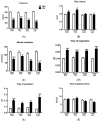Effects of Thymus vulgaris L., Cinnamomum verum J.Presl and Cymbopogon nardus (L.) Rendle Essential Oils in the Endotoxin-induced Acute Airway Inflammation Mouse Model
- PMID: 32759721
- PMCID: PMC7436258
- DOI: 10.3390/molecules25153553
Effects of Thymus vulgaris L., Cinnamomum verum J.Presl and Cymbopogon nardus (L.) Rendle Essential Oils in the Endotoxin-induced Acute Airway Inflammation Mouse Model
Abstract
Thyme (TO), cinnamon (CO), and Ceylon type lemongrass (LO) essential oils (EOs) are commonly used for inhalation. However, their effects and mechanisms on inflammatory processes are not well-documented, and the number of in vivo data that would be important to determine their potential benefits or risks is low. Therefore, we analyzed the chemical composition and investigated the activity of TO, CO, and LO on airway functions and inflammatory parameters in an acute pneumonitis mouse model. The components of commercially available EOs were measured by gas chromatography-mass spectrometry. Airway inflammation was induced by intratracheal endotoxin administration in mice. EOs were inhaled during the experiments. Airway function and hyperresponsiveness were determined by unrestrained whole-body plethysmography on conscious animals. Myeloperoxidase (MPO) activity was measured by spectrophotometry from lung tissue homogenates, from which semiquantitative histopathological scores were assessed. The main components of TO, CO, and LO were thymol, cinnamaldehyde, and citronellal, respectively. We provide here the first evidence that TO and CO reduce inflammatory airway hyperresponsiveness and certain cellular inflammatory parameters, so they can potentially be considered as adjuvant treatments in respiratory inflammatory conditions. In contrast, Ceylon type LO inhalation might have an irritant effect (e.g., increased airway hyperresponsiveness and MPO activity) on the inflamed airways, and therefore should be avoided.
Keywords: airway hyperresponsiveness; airway inflammation; cinnamon; endotoxin; essential oil; lemongrass; mouse model; myeloperoxidase activity; perivascular edema; thyme.
Conflict of interest statement
The authors declare no conflict of interest. The funders had no role in the design of the study; in the collection, analyses, or interpretation of data; in the writing of the manuscript, or in the decision to publish the results.
Figures





References
-
- WHO The Top 10 Causes of Death. [(accessed on 16 July 2020)]; Available online: https://www.who.int/en/news-room/fact-sheets/detail/the-top-10-causes-of....
-
- Baser K.H.C., Buchbauer G. Handbook of Essential Oils: Science, Technology, and Application. CRC Press (Taylor & Francis Group); Boca Raton, FL, USA: 2010.
-
- Faleiro M.L., Miguel M.G. Use of essential oils and their components again multidrug-resistant bacteria. In: Rai M.K., Kon K.V., editors. Fighting Multidrug Resistance with Herbal Extracts, Essential Oils and their Components. Elsevier; San Diego, CA, USA: 2013.
MeSH terms
Substances
Grants and funding
- EFOP-3.6.2-16-2017-00008/Emberi Erőforrás Fejlesztési Operatív Program
- GINOP-2.3.2 STAY ALIVE/Gazdaságfejlesztési és Innovációs Operatív Program
- ÚNKP-19-3-III-PTE-211/New National Excellence Program of the Ministry of Human Capacities, Hungary
- BO/0004/18/5/János Bolyai Research Scholarship of the Hungarian Academy of Sciences
LinkOut - more resources
Full Text Sources
Research Materials
Miscellaneous

